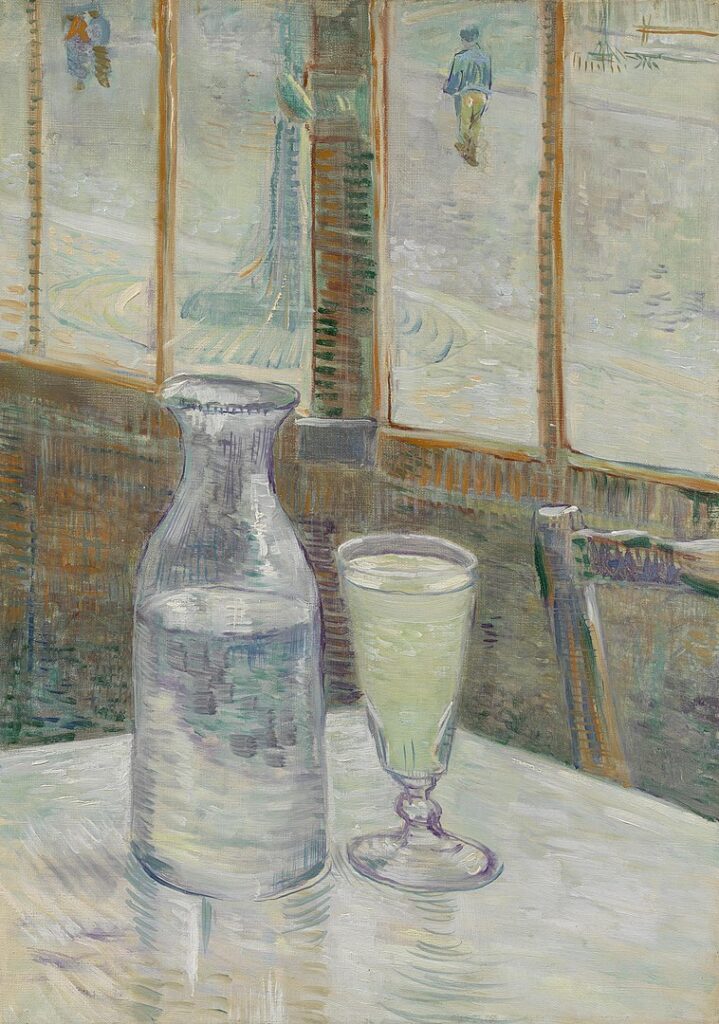
Her story is a good old fashioned cautionary tale. A small town girl who, through a perfect storm of events, becomes the biggest thing in the known world. She catapults to fame, becomes the muse of the writers and the philosophers and the painters, who write about her, philosophize about her, and use her as a model. She changes the way of life in Paris during its famous Belle Epoque. But alas, before she can even enjoy her fame, her world collapses. She’s blamed for the emasculation of men, for violence, for the downfall of French society. She is blamed for murder. And just like that, she is cast out, unwelcome, marked. This is the story of Absinthe.
Absinthe’s story starts in Ancients Egypt and Greece. It wasn’t Absinthe then, but just wormwood, which, like so many other things that would become booze, was used medically. It was used for stomach aches and lung ailments. The Greeks soaked leaves in wormwood and had a fortified wine called absinthites oinos. During the Bubonic Plague wormwood was burned and used to fumigate houses with infected people. You’ll be stunned to learn this didn’t really work. The rats and their fleas weren’t terribly concerned about the fire. Absinthe pops up as a drink in Switzerland in the late 18th century, where doctors used it as a cure-all elixir. Part of the global trend towards alcohol-based medicines. They made you feel better, but when you’ve just had a shot of 140 proof liquor, you’re not going to notice your femur sticking out of your leg, let alone a sore throat. But Absinthe really starts spreading its wings during the French (always the French) campaign in Algeria in the 1840s, where French soldiers were given it as an anti-malarial. The soldiers loved Absinthe. And when they came home they brought it with them.
Normally French wine would have scoffed at some newcomer to the booze scene. The French have a relationship with wine that only rivals their love for Jerry Lewis, cigarettes, and sleeping with more than one person at a time. Never could another booze overtake wine. Usually. But a massive wine blight being caused by a grape lice which was brought to France from the U.S. (they probably didn’t realize that when they gave us the Statue of Liberty). So with wine production diminished and the French still looking for booze to help them yell at people with poorly-accented French, in stepped Absinthe. And boy did it take off. For a while, everything was green. It was so popular that instead of happy, 5 o’clock was called the Green Hour. Absinthe had the added attraction of coming along in a catchy color (green), neato terminology (the green hour), a mascot (the green fairy), cool tools and a process (slotted spoon, reservoir glass, cold water, sugar, low morals).
Absinthe was soon the drink of Paris’ artistic community. It became the ‘muse in a bottle’ with a who’s who list of artists dedicated to its supposed mind altering effects. Edward Manet, Paul Gaugin, and Picasso all painted their darling. Toulouse-Lautrec carried around a hollowed out cane (for his underdeveloped legs) which held a vial of, you guessed it, absinthe. Lautrec also painted Vincent Van Gogh drunk on Absinthe, which is synonymous with Van Gogh when he was awake. Other artists got in on the fad. Rimbaud, Verlaine, Baudelaire, Hemingway, Zola, Oscar Wilde, and Guy Maupassant were all dedicated absintheurs. Oscar Wilde said: “After the first glass of absinthe you see things as you wish they were. After the second you see them as they are not. Finally you see things as they really are, and that is the most horrible thing in the world.” Terrifying? Yes. But no other alcohol ever had such a reputation as the booze muse.
The art it produced is terrifying, too. Absinthe paintings leave one as uneasy as those depicted in them. The spooky green fairy, the haunted green look on the drinkers’ faces. But it is partly responsible for a laundry list of artistic movements – Symbolism, Surrealism, Modernism, Impressionism, Post-Impressionism, Cubism, and some isms that were surely lost in the haze of the green liquid. It may have spawned some of the world’s most famous art, but it took its toll on the artists. Van Gogh’s mental decline was rapid as he tried to keep the demons at bay with copious amounts of absinthe. Rimbaud complemented absinthe with hash. Baudelaire did him one better and used laudanum and opium with his absinthe. Lautrec went into a terrible decline and died at 36. Rimbaud died at 51, but not before he was shot by a drunk Paul Verlaine. Fortunately Verlaine was too drunk to hit much. Van Gogh threatened Gaugin with a razor and then used it to slice off his ear. Those absintheurs who didn’t lose their marbles, died young and drunk. And the Belle Epoque seems like a bad episode of the Real Housewives of Paris.
Absinthe soon got the blame for so much more than just dying artists. A man in Switzerland murdered his wife and children in a blind drunk rage. Despite the fact that he had had brandy and four bottles of wine, the murders were blamed on the two glasses of absinthe. (Remember that time you had sixteen beers and a glass of wine and blamed puking your guts out on ‘mixing boozes’? Yeah, it was kind of like that.) And this growing fear of absinthe was soon overwhelming the country. France had just lost the Franco-Prussian War, were in need of fit men, and were nervously eying their aggressive Teutonic neighbors (but Germany never caused any more problems really). They saw absinthe as diminishing the males of France and as the cause of the dissolution of French society, as opposed to it being, you know, full of French people.
Absinthe became public enemy numéro un. Just like gin in England before it and whiskey in the US, the ills, failings, and problems of society were blamed on absinthe. Unfairly, too. Despite absinthe’s reputation as a hallucinogenic gateway to an otherworldly experience, it was all just good PR. the process of diluting sugar and the cold water and the neato spoon and glass – all good PR. To get hallucinations from wormwood you’d have to drink a baby pool of it. So absinthe’s high alcohol content just got people good ole fashioned fucked up. Nevertheless, by 1915 it was banned in most places. Today we celebrate the Green Fairy during the Green Hour with our Green Liquor.
Ingredients
- A bottle of Absinthe
- A glass (reservoir, if possible)
- A freezing cold bottle of distilled water (cold, cold. Freezing cold. Think Jack Nicholson in the hedge maze at the end of The Shining)
- A slotted spoon (or a fork with no spaghetti on it)
- Sugar cubes
- An olive oil dropper
- No plans or no need to be in public or around others
- About 300 meters between you and your car keys
Directions
Pour about 1 ounce of absinthe into an absinthe glass. If you have a reservoir glass, then the little reservoir at the bottom is made to hold an ounce of liquid. So you can just fill that with absinthe. This makes it easy to know how much absinthe to add without measuring anything, because measuring absinthe will became far more difficult after drinking absinthe. If you don’t have a reservoir glass, measure out an ounce of absinthe and pour it in the glass. Do not do any more than an ounce. There are many times to be a hero, when you are drinking absinthe is not one of them.
Lay an absinthe spoon (or fork) across the top of the glass rim and place a sugar cube on the spoon. Make sure the olive oil dropper is clean and attach it to the top of the water bottle. Now slowly pour the ice-cold distilled water onto the sugar, just enough to saturate it. Allow it to sit until the sugar cube begins to dissolve. Pour more water over the sugar (again, slowly) until the sugar is completely dissolved. You should be aiming for about 3 to 5 parts water to 1 part absinthe. As the water hits the liquor, the louche will swirl through the liquid, creating a milky opaque effect, while the sugar should take away some of the absinthe’s harsh bitterness (and maybe even yours), and release the absinthe’s herbal bouquet. Allow the louche to rest, then stir in the rest of the sugar. Then have at it. Remember, absinthe may not be hallucinogenic, but it’s between 45 and 75 percent alcohol, so no cars, bikes, dancing, or messaging anyone. Drink to the Green Fairy, to its bad rap, and to Vincent Van Gogh’s ear.
